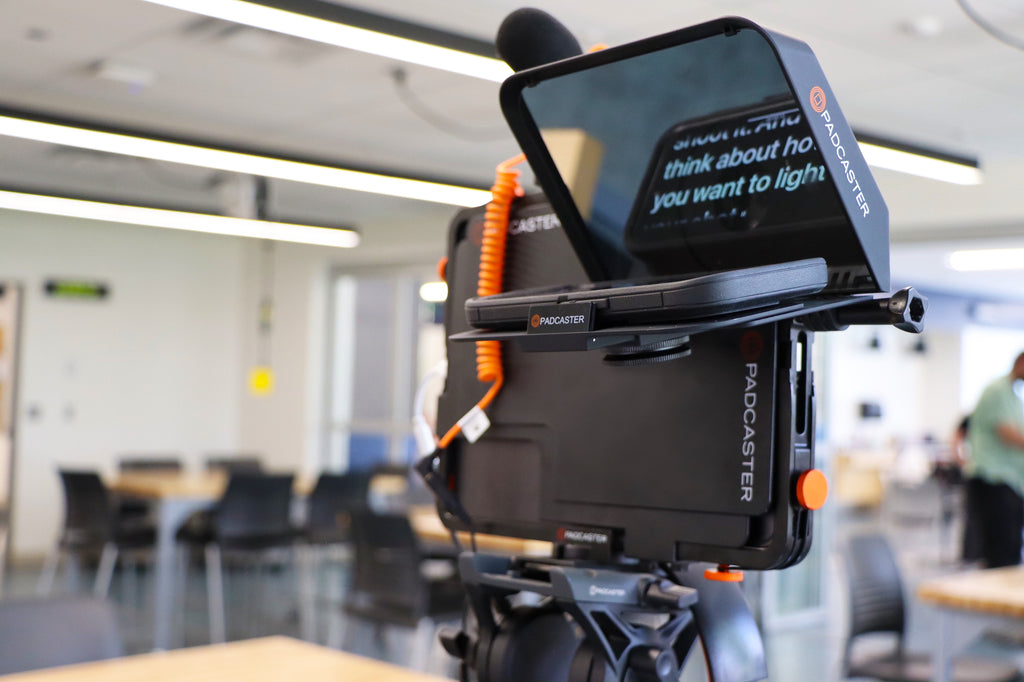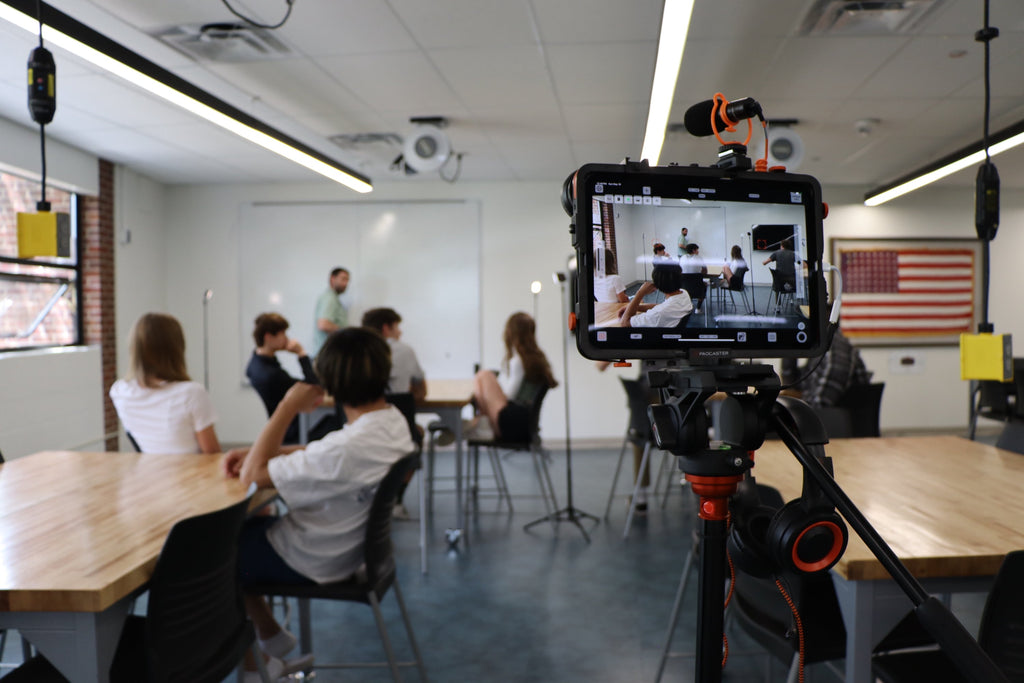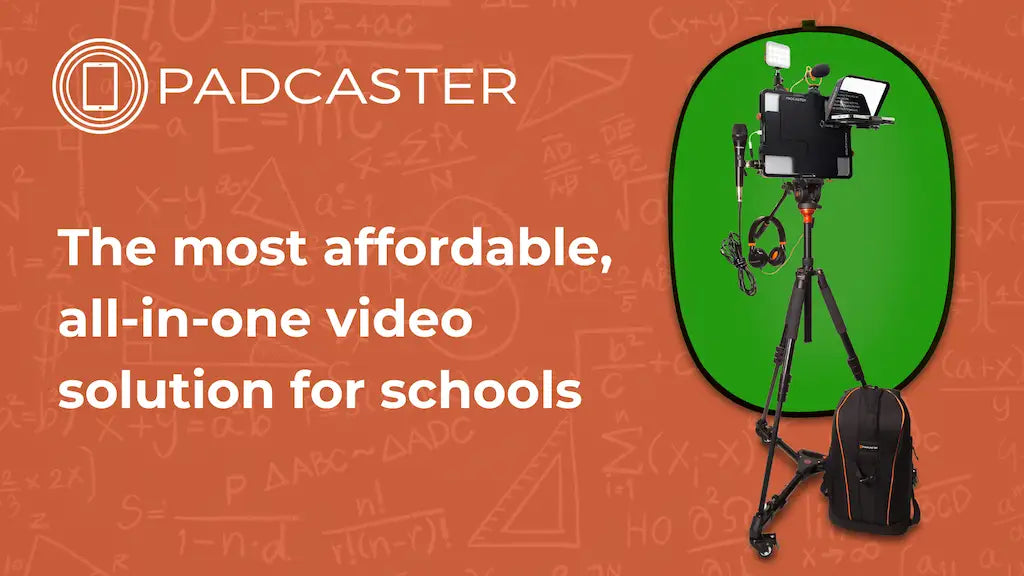
Livestreaming school sporting events is rapidly becoming a popular way for schools to teach media production to their students. By broadcasting these important events live, educators are giving their student tech teams real-world filmmaking experience and opening up an opportunity for families to watch their children compete. Padcaster spoke with dedicated educators Jay Greth and JR Renna of Parkland School District in Allentown, PA about livestreaming school sports with the Padcaster, their robust media program, and the dynamic student tech team behind it all.
How did you get started with the Padcaster and livestreaming?
JR: Back around the time all of our principals were getting onto Twitter we wanted to help them flatten the walls of their schools and let everybody see the awesome things that are happening with media education. We also wanted to give students the ability to do digital storytelling topics. I had a Padcaster at my previous district, and then I had the opportunity to get one for each building at Parkland. Now we have at least two Padcasters for each building in the district and a couple more than that at the high school. The Padcaster system provides a nice blend of new media and traditional storytelling opportunities.
One of our first major livestreaming opportunities was our highly anticipated Staff Vs. Students basketball game. The 2019 game was the first opportunity for our middle school tech teams to try a real live broadcast and experience all the pressure that comes with it.
Fast forward to the pandemic and we needed to livestream a whole lot more things and that's where Jay and his team really stretched themselves to meet that demand.
When you decided you were going to live stream the Staff Vs. Student game basketball game, did you practice going live with your students beforehand?
JR: Yes! It was important to the students to try and make the livestream as close to a televised NBA game as possible.
The Staff Vs. Student game was very, very high stakes, but we couldn’t fit all the kids in the school into the gymnasium. So we had the eighth-graders in the bleachers and sixth and seventh graders watching the livestream from other parts of the school. It was also nice to be able to stream the game for the spouses of the faculty as well as parents of the students playing.
A big thing was testing out the PA system because we have some particularly hilarious teachers who do play by plays and live commentary. That was an integral part of the broadcast so we had to make sure that we tested that in advance to make sure that it worked.
Prior to the game, we made sure everyone on the tech team had their role and was comfortable with it. We had students in all major roles and we established a backchannel for how they were going to communicate with each other during the broadcast to make sure it was going smoothly.
We try to make sure to have a growth mindset with our students, which means that it's not going to be right and perfect the first time through. It certainly wasn't that first year we tried to broadcast the game and we learned a lot from that first stream and didn't let that get us down the second time around. The 2020 broadcast we ended up being able to broadcast out to YouTube live as well as the school network and that worked out pretty awesome.
So how has the program changed over the years? Are you still just streaming the basketball games? Are you broadcasting multiple sports?
Jay: Every single sport that Parkland puts on we are streaming.
We use the Padcaster system primarily as a modular subsystem to livestream multiple events going on at the same time. Most recently it has been filming swim meets and the Padcaster has been able to provide comfort and ease of use to the tech teams as well as the ability to stream directly from our network onto YouTube Channel ParklandTV.
Tell me about your student tech teams. Are your students running the entire show? How does that program work?
Jay: At the high school the students are running the entire program. I function as the advisor and help them solve problems as they're going through it but I really enjoy having the students in charge of operating everything. They run the program just like a typical TV production studio. Students are managing themselves, their schedules, the scheduling the broadcast of the sporting events, and all the staffing that it involves.
They're creating the graphics and the procedures with which they will try different things at different times for different sports. As JR said, when mistakes are made, we move past it and recognize that everybody saw it, but continue fine-tuning those broadcasts for next time. It has enabled us to really create some impressive projects.
Wow, that sounds like an incredibly impressive program! How are the roles decided upon?
Jay: At the end of each year, they have an application process where the students apply for various positions.
Student applicants will create a presentation and present it to the current seniors and to the advisor. By doing it this way, students who want those positions will have to interview for them. Then a committee of the seniors on the tech team will discuss the various candidates for the position going all the way from executive producer down to equipment manager. After that discussion, we decide which students we feel are going to be best for those positions moving forward into the next year.
That's such a great opportunity for students to experience an interview process early on in their lives. Do students hold that position for the whole next year?
Jay: They have the position for the whole year so that they can plan their actual school schedule around what they've decided to do in the TV studio. Kids that are in more executive roles, like the executive producer, usually choose to take an extra TV course, so they can be in the studio a little bit more every day.
Is there a period at the beginning of the year where older students mentor the younger students in those positions?
Jay: Typically we have a probationary period. Those freshmen who are taking Intro to Mass Comm and have the time during their study hall will come help out in the TV studio. They then get to see how all of the different positions are run, how the productions are put together and ask questions of the older students.
After that, they can come do a basketball game broadcast with us and observe how everything works in action. Quite frankly, the students are really good at teaching each other because they want to see other people succeed in the things that they like doing.
When you have passion combined with this direct motivation to do well, to create something that other people really like to see and watch, you see students put an impressive amount of dedication and effort into doing things.
I would've loved to have had a program like this when I was in high school!
Jay: I'm building the program that I would have wanted to have had when I was their age. I am, unfortunately, old enough to remember having one Mac and using VHS decks to edit on. I’m constantly looking and seeing what kind of innovative equipment is out there and what I would have wanted to play with when I was in high school, that's kind of how I manage the equipment side of the program.
It’s really awesome that you are providing your students with this kind of opportunity. Do you find that some of these students are able to use this experience and build video portfolios to take to apply to colleges?
Jay: Absolutely! Our executive producer this year is applying to universities that are in the top ranks of the nation. He's looking into NYU's Tisch program and that's where he’s looking to go to college. We're talking about a student who, when he first started school, didn’t even know what the school TV studio was and through our program has discovered a passion that has ignited a desire to pursue creating these projects as a career.
I also have two underclassmen who are trying to attend the Boston college MassComm program over the summer and it’s clear they are dedicated beyond the normal school day
That's so inspiring. Are you using the Padcaster for anything besides sporting events? Has your team branched out into streaming school plays or concerts?
Jay: Our theater department uses the Padcaster a lot for student college applications. They use the Padcaster to film their audition videos for some of the top theater colleges in the nation. The Padcaster has been so helpful because it’s so easy to use and mobile that students are able to do multiple takes without having to worry about a complicated setup and tear down.
As far as the school band goes, I know that individual students are able to use the Padcaster to practice new music and then send those recordings to their instructors.
JR: The theater program has their own Padcaster at the high school and one of the ways they’re using the Padcaster that I thought was particularly cool is the instructor connects it to her projector and uses it when they're teaching the difference between blocking, staging, and framing a scene. The theater instructor is able to show students visually how framing enhances or helps to tell a story. What’s great is I didn’t tell her that she could use the Padcaster for that. She reached out to our student tech team directly at the high school and they helped her set it up on the TV.
I'm also using it for the Read Across America program. We usually have a wonderful program where our administrators, parents, and volunteers are able to come in and read to the kids. It was a lot harder to do that this year, for obvious reasons, but we still wanted to provide that experience. Our solution was to use the Padcaster to record it! I started working with our superintendent and assistant superintendent on recording the stories and reading them aloud.
I've recorded quite a few messages with the superintendent to reach out to the community throughout the pandemic. On a whim, I got a request to record a message thanking our staff and substitute teachers for all the hard work they put in. Because of the way I had the Padcaster set up with two mics mounted, and everything rigged it to a small mixer board, I was able to run two channels so I could record the superintendent and the HR director simultaneously. We were able to capture that video very quickly and get it up to YouTube the same day.
It's handy to have the Padcaster around because I end up doing quick little videos like that all of the time. It gets quite a bit of use at the ad center.
I love the idea of using the Padcaster as a way to connect and inform the community. I spoke to an assistant superintendent in Texas that was also using a way to disseminate information to parents. When you and your team are livestreaming an event or game, how much prep work is going on before you start? Do you launch the broadcast early with a placeholder graphic for those tuning in early?
Jay: We have a placeholder graphic up before the stream starts. We have a scoreboard through the sling studio to manage it.
For some other sports, we have full graphics the entire time. When I say graphics I’m talking about station IDs, logos etc. We aren’t at the point of doing a live pre-show, color commentary or play-by-play for every game yet but it’s definitely a goal.
JR: I had much less pressure filming the Staff Vs. Student game because I had a dozen-plus kids in each of the middle schools preparing to run those live broadcasts. I had a lot more time and a lot less pressure because we had been planning for longer.
Part of our pre-production for that particular game is to make sure that friendly smack talk gets captured. We make an effort to record students before the game starts and that’s what runs in the pregame. Our student broadcast team also put together a Google slides presentation of all the players with a baseball card style slide for each of the players that they loop into the broadcast.
Jay's broadcasts typically have a countdown before the stream goes live. Jay, you typically have a stock countdown that you run when the game is about to go live too, right?
Jay: For our normal daily broadcasts, we do that but when we are setting up for our streaming sports events there is a countdown feature in YouTube live schedule that we use.
As we progressed through the year and wanted to livestream more and more games, the students figured out that it was much easier to have everyone subscribed to our YouTube channel. That way they would get an automatic notification every time we broadcasted new sports.
Did you have to walk through how to access these streams with any parents or family members who aren’t as tech-savvy?
Jay: It was really great because the students and the student-athletes really helped spread the word about how the coverage was being shown and how to access it. The kids take a lot of initiative when they want their family members to be able to watch them play.
Have you seen a desire coming from the student tech teams about expanding the program and trying new things? What about the student-athletes, how are they reacting to the live broadcasts?
Jay: There is a lot of collaboration and brainstorming going on. We really want to do more pre-show stuff especially after seeing JR was able to pull off at the Staff Vs. Student game.
From the athletes’ perspectives, not only do they get to participate in the game, but when they get home, they can rewatch it. They can go back and create and analyze how they think they did by actually physically watching how they performed.
As your program grows, is there a plan to build out your student tv program into separate teams? As in separate broadcasting teams for sports, events, morning news, and announcements?
Jay: We physically don't have that separation yet because our program is still growing and with everything being so complicated this year, there really was no ability to divide and conquer. Everyone had to be able to do everything but as we progress further, I think that that separation will occur. There has also been discussion of possibly adding courses on specific types of broadcasting, like sports broadcasting for instance.
Right now we’re still building out the program and trying to give everyone a chance to learn about each position. We have those kids who like to be leaders and want to produce, and you have those other kids who want to be able to put their voice to the action that you're seeing. They want to focus on learning more about those specific positions.
How do students find out about the tech team? Do they start with media classes as freshmen?
Jay: Parkland does a really great job from elementary through high school in providing the technology to support these types of programs. Every elementary building has a Padcaster, so if a teacher wants to do a project where kids want to be on camera they have what they need to do it. Each elementary and middle school does a daily student featured broadcast with the Padcaster.
When they get to high school, they've been involved in those programs, and they've already been able to try out different aspects of it. By the time they get to me, they kind of know where they want to go and which position they want to pursue.
That's such an incredible opportunity you are giving to your students. It’s so great to hear that so many different teachers and students get to use a Padcaster. What would you say your favorite aspects of the Padcaster are?
Jay: The ease of use and the fact that if a teacher has a bright idea for a video or project and they want to do it quickly, using the Padcaster is the easiest way to do it. I love that you can roll a Padcaster into a classroom, and it's very easy for both students and teachers to use. I'm trying to think how many times I've remotely had to tell someone how to use the Padcaster over the phone and I’ve lost count! Teachers are always telling me how easy it is for them to manipulate it, to put it where it's supposed to be in order to get a great shot. They love the microphone because now their videos have great sound.
They are able to easily use the Padcaster and YouTube to broadcast live from a different location, and I am able to watch what they were doing and help if I need to. I would say just the ease of use when filming with the Padcaster is just something that can't be compared to any other system.

I love hearing that teachers and students are enjoying using it. Do you have any advice for other educators who want to do a similar broadcast program to what you both are doing in Parkland?
Jay: I would say that as soon as you get the tools you need, get them into the kids in their hands, and they'll start finding a way to learn how to use it.
Kids are not afraid of going on YouTube and looking for tutorials, looking to see what other people have done and compare what they're doing and how to make it better. It's not quite a competition, but there is definitely a sense of rivalry in trying to do something in a more interesting or creative way than they've seen it done before.
Padcaster transforms your iPad or smartphone into an all-in-one mobile production studio so you can create professional-quality videos from your home or anywhere else. Whether it’s for distance learning, telecommuting, remote broadcasting or livestreaming -- Padcaster will help you produce high-quality content wherever you are. If you’re considering having an event online such as a wedding, religious service, graduation, or ‘gathering’ of any kind, Padcaster wants to help you! Fill out the form below to get in touch with one of our sales consultants!
Need More Information?
Fill out the form here to get in touch with a member of the Padcaster Team.


